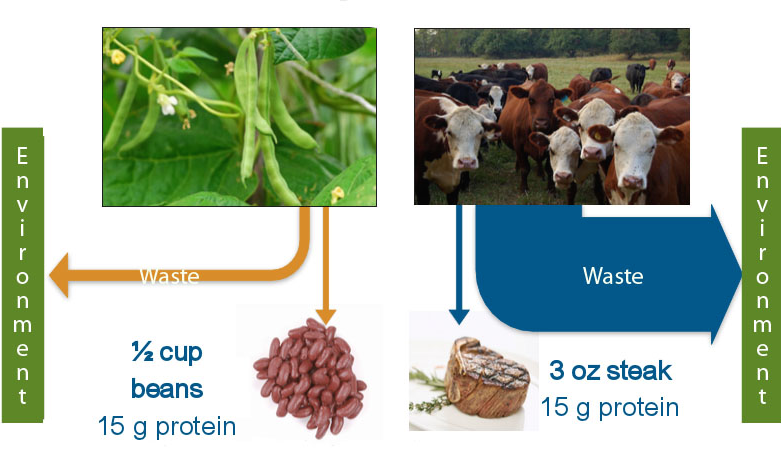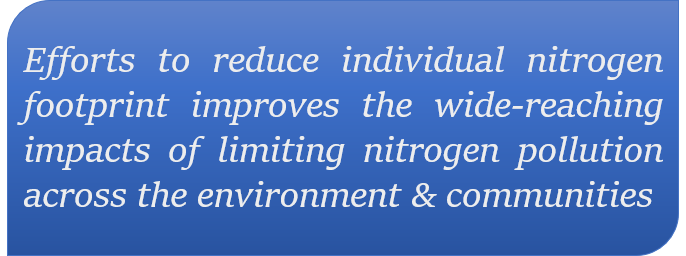Now that you know what your nitrogen footprint is, what can you do to influence it?
Read on to learn how you can make small changes every day that can have a big effect on your nitrogen footprint.
 Food
Food
- Choose more plant-based protein. A balanced diet includes protein from both plant and animal sources, and making sure you receive protein from both is good for both your health and for the environment.
- Choose foods produced on more sustainable farms. Sustainable farms use practices that reduce their amount of nitrogen fertilizer runoff into the water and air. If they raise livestock, they take care to manage their manure so it doesn’t pollute.
- Adjust your food consumption to include only the recommended dietary protein needs. A protein-heavy diet is nitrogen-intensive, since nitrogen is a critical component of protein production and is a component of protein itself. The Dietary Reference Intake (DRI) recommendation is 0.36 grams of protein per pound of body weight per day for adults (or 0.8 g protein per kg body weight). See this document from the USDA or page 4 of this document from the Institute of Medicine for more information. If you eat more than your recommended protein intake, try replacing some protein with other types of food like fruits, vegetables and grains.
- If you eat animal protein, consider a less N-intensive meat. The production of different types of meat involves
 distinct processes that release different amounts of nitrogen to the environment. For example, chicken production is less N-intensive than beef production. This means that per unit of nitrogen you consume in chicken, less nitrogen is released to the environment compared to the amount to produce a unit of beef nitrogen.
distinct processes that release different amounts of nitrogen to the environment. For example, chicken production is less N-intensive than beef production. This means that per unit of nitrogen you consume in chicken, less nitrogen is released to the environment compared to the amount to produce a unit of beef nitrogen. - Reduce your food waste! In the US, about 30% of food is wasted at the retailer, foodservice and consumer levels (see Kantor's "Estimating and Addressing America's Food Losses"). Cutting down on food waste would reduce the amount of food that needs to be produced, which could cause a large reduction the amount of N released to the environment from food production.
Energy
- Limit your household utility usage by using more efficient appliances.
- Reduce your electricity usage by turning off lights and appliances you are not using.
- Purchase green power. This is usually a small surcharge on your electricity bill for renewable energy. Contact your local utility.
- Check out your region's fuel mix using the EPA's Power Profiler tool.

- Lower your utility usage by setting your thermostat to a higher temperature in the summer and a lower temperature in the winter.
- Choose more sustainable transportation methods like carpooling, public transit, bicycling, or walking.
- Purchase a car that uses less gas, such as a hybrid vehicle.
- Reduce your consumption of goods and services by limiting unnecessary purchases, reusing, and recycling.
It is important to note that doing many of these things even just one day a week can make a big difference over time. Most of these lifestyle changes will reduce not only your nitrogen footprint, but also your carbon footprint and your ecological footprint. These changes will generally lead you to live a more sustainable life.
What else can you do to reduce nitrogen pollution?
Your individual efforts to reduce your nitrogen footprint can have a big impact on nitrogen pollution and on the environment.

We already know how to reduce our nitrogen footprint: support agricultural production that optimizes nitrogen fertilizer user, choose a diet with less animal protein, and minimize fuel-heavy forms of transportation like airplane travel. These suggestions aren’t unique to reducing nitrogen pollution– many people trying to create more healthy communities are calling for these changes. You can go one step beyond your personal lifestyle choices and join others in calling for:
- More renewable electricity choices from your local utility, such as wind and solar power
- Increasing government support for sustainable farming practices
- Greater use of safe herbicides and fertilizers
